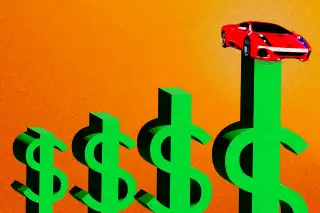New Car Prices Just Hit a Record High — but the Market's Improving for Most Buyers

The average price paid for a new car just reached an all-time high. But the rising average may be more an indication of what kind of vehicles shoppers are buying rather than people getting ripped off at the dealership.
Car prices are generally trending higher as more Americans opt to buy expensive luxury vehicles, a new report from Kelley Blue Book shows. As for non-luxury vehicles, prices have generally been stable or even declined in November.
The average transaction price for new vehicles was $48,681 in November, beating the previous record high of $48,301, from August. Average new car prices increased by $422 in the past month and are up $2,250 in the past year.
Prices have now increased in back-to-back months despite high auto loan interest rates and improving inventory of new vehicles, both of which are factors that put downward pressure on prices.
How is that possible? Kelley Blue Book experts say growth in the luxury vehicle market is lifting the average price for new cars. "Strong luxury vehicle sales have been a primary reason for overall elevated new-vehicle prices," the company reports.
Some new car prices are falling
In November, 18.2% of all sales were luxury vehicles, which is a record and an increase from 17.8% in October. Three years ago, in November 2019, luxury vehicles sales were 16.1% of the market.
The average transaction price of luxury vehicles was $67,050 in November, compared to $44,584 for non-luxury vehicles. The more luxury vehicles Americans buy, the higher the overall average price for new vehicles. But that effect doesn't necessarily mean buyers are getting less bang for their buck.
The good news is non-luxury buyers aren’t paying as much above MSRP (the sticker price) as they were just a few months ago. In November, non-luxury car buyers paid an average of $410 above sticker price, down from $1,102 in August, according to Kelley Blue Book.
Average transaction prices declined from October to November for a number of brands that are big in the non-luxury category, including Honda (-2.6%), Kia (-1.4%), Hyundai (-1.2%), Chevrolet (-0.8%) and Mazda (-0.1%).
Some experts say buyers could have a better time finding genuinely good deals on new cars in 2023 as the supply and demand imbalance appears to be trending toward normalizing. There's still strong demand for the new vehicles that are available, but eventually manufacturers and dealerships will likely want to lure more buyers into the market with deals and incentives.
Thanks to interest rate hikes this year from the Federal Reserve, the average auto loan interest rate for new vehicle purchases is about 6.3%, up from 4.2% one year before, according to the latest update from Edmunds.
Higher auto loan rates likely contributed to a slower pace of new vehicle sales in November compared to October: Total new sales slumped roughly 4% month to month, according to Kelley Blue Book. Some prospective buyers are apparently being discouraged from financing new vehicle purchases due to how much interest they'd have to pay each month. The average monthly loan payment on a new car purchase is over $700 as a result of high interest rates (and high prices).
Used vehicle prices have finally been declining since the Fed raised rates, but that trend hasn’t really been seen yet with new cars. Supply chain and production challenges have contributed to low new vehicle inventory, which is keeping prices high. Inventories are now getting stronger, but remain well-below pre-pandemic levels.
"New-vehicle inventory is steadily improving, though some brands have a noticeably larger supply than others," Kelley Blue Book reports.